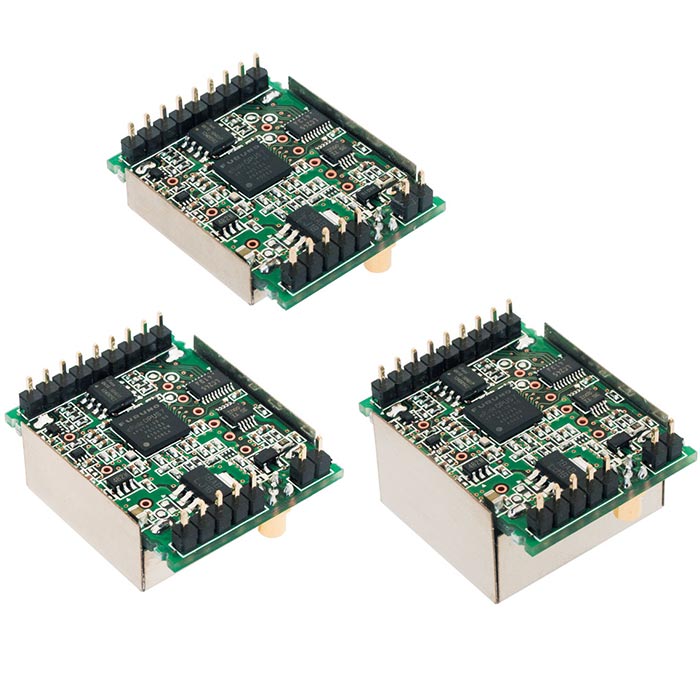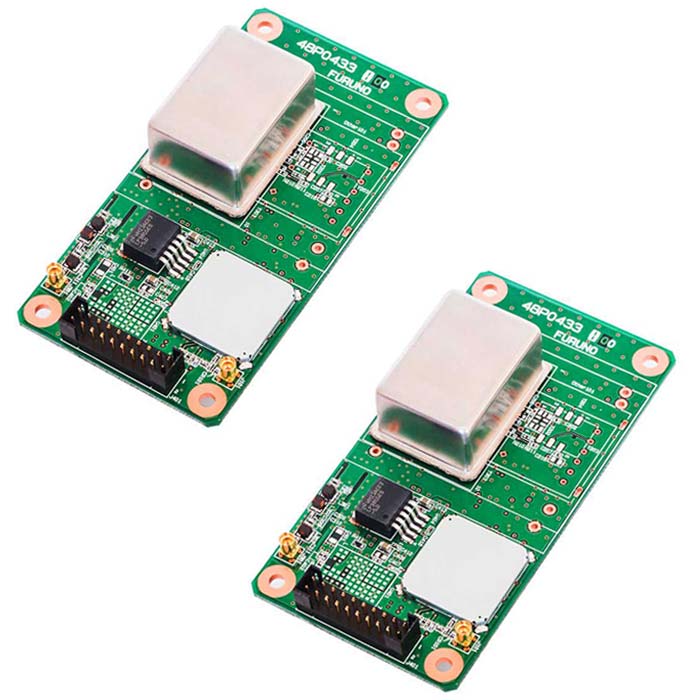Technology
FURUNO GPS/Multi-GNSS Disciplined Oscillator (GPSDO/GNSSDO)
What is a GPS/Multi-GNSS Disciplined Oscillator (GPSDO/GNSSDO)?
The GNSS* satellites including GPS satellites have ultrahigh-performance atomic oscillators. The accuracy of the satellite’s atomic oscillators is controlled and maintained from the ground stations. The GPS/Multi-GNSS Disciplined Oscillator receives GPS/GNSS satellite signals and outputs highly accurate and precise time pulse (1PPS) and reference frequency by controlling its own oscillator with the precise time provided by the GPS/GNSS receiver. They are also called GPSDO(GPS Disciplined Oscillator)and GNSSDO(GNSS Disciplined Oscillator).
Periodical calibration work is not necessary since GPSDO/GNSSDO compensates time pulse and reference frequency continuously by using GPS/GNSS.
The GPSDO/GNSSDO controls the frequency output of its own oscillators (TCXO or OCXO) and achieves at a much lower cost, superior performance than an atomic oscillator (Rubidium or Cesium) replacement.
Now days GPSDO/GNSSDO are used extensively in large infrastructures requiring precise time, reference frequency and time synchronization, such as digital terrestrial broadcast base stations, cell phone base stations and wireless communication network systems.
- *
- GNSS (Global Navigation Satellite System)
GNSS (Global Navigation Satellite System) is a satellite system that is used for positioning by receiving its satellite signals. The GPS of United States, GLONASS of Russia and Galileo of Europe are now in operation or are about to start operation. Japan launched “Michibiki” of QZSS (Quasi-Zenith Satellite System) in 2010.
Example of frequency control
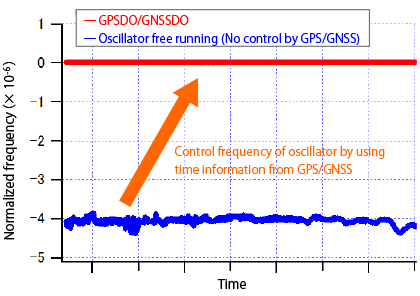
Interruption of satellite signals (Holdover function)
As explained above, a GPSDO/GNSSDO controls the frequency of its oscillator by using the received GPS/GNSS signals. However, exogenous noise such as jamming signal or failure of GPS/GNSS antenna by lightning strike may cause the GPS/GNSS receiver to loose lock with the GPS/GNSS satellite signals. A GPSDO/GNSSDO is used in infrastructures that must continue to operate through such interruptions. In these circumstances the GPSDO/GNSSDO shall continue to output highly accurate and precise timing (time pulse and reference frequency) for a certain period time (Holdover status). To achieve this requirement, the Holdover Function (Holdover Control) is available.
When the GPS/GNSS receiver looses lock, the GPSDO/GNSSDO outputs timing by using the intrinsic performance of its oscillator. Higher is the performance requirement in Holdover mode, the more expensive and larger size oscillator (OCXO vs TCXO) should be used in the GPSDO/GNSSDO.
Yet when the GPS/GNSS receiver looses lock, the GPSDO/GNSSDO oscillator is controlled to maintain timing performance by learning the frequency characteristic (Aging, temperature characteristic and etc) during GPS/GNSS lock condition thanks to Furuno’s Holdover Function. The Holdover performance is significantly defined by how accurately the GPSDO/GNSSDO learns its oscillator’s frequency characteristic. Furuno steps up the effort to improve oscillator control technology by providing Furuno GPSDO/GNSSDO to digital terrestrial broadcast base stations, cell phone base stations and wireless communication network systems which support foundations of countries.
The new Multi-GNSSDO GF-8805, which was announced on January 2015 achieves accuracy within 1.5μs (specification value), the world best-in-class holdover performance even if the GNSS receiver looses lock for 24 hours. The GNSSDO receives multiple GNSS satellites, such as GPS, GLONASS, QZSS and SBAS concurrently. As the GNSSDO receives GPS and GLONASS signals concurrently, from two different frequency bands, if the receiver looses the lock condition on either GPS or GLONASS, the GNSSDO can continue to control its oscillator by using the other satellite signals. This decreases the possibility to enter the holdover status.
Multi-GNSS disciplined oscillator GF-8805 1PPS accuracy
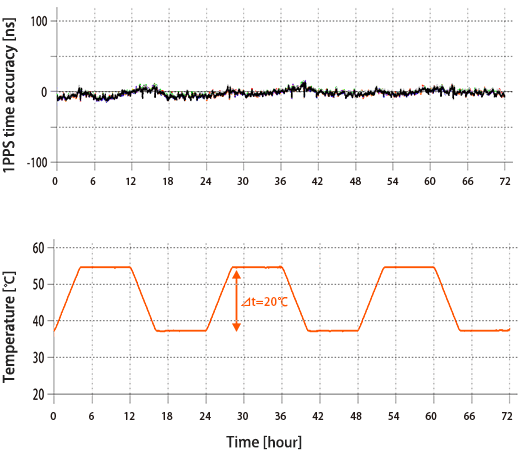
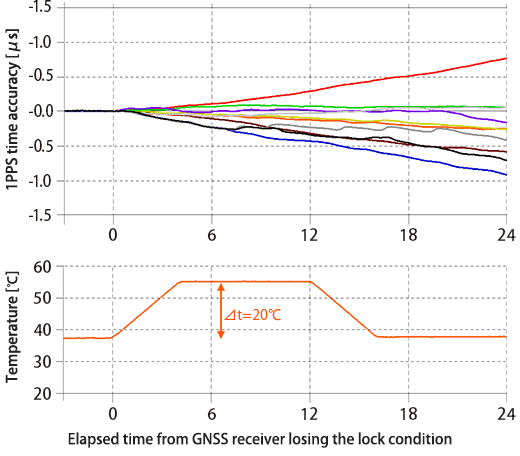
Furuno Advanced Multi-GNSS Disciplined Oscillator
Furuno Advanced Multi-GNSS Disciplined Oscillator supports concurrent reception of GPS, GLONASS, QZSS and SBAS. A variety of product line up is available depending on holdover performance, low phase noise performance of reference frequency, size and cost. Furuno Advanced GNSSDO supports Active Anti-Jamming functions and Multipath Mitigation functions and provides highly accurate and stable 1PPS synchronized with UTC time as well as highly stable frequency coherent to 1PPS.
Small size model
[TCXO/OCXO equipped]Highly accurate and low phase noise model
[OCXO equipped]* The GF-8801/GF-8802/GF-8803/GF-8804/GF-8805 use the same communication protocol.
The GF-8801, GF-8802 and GF-8803 have the same footprint and are pin-to-pin compatible. The GF-8804 and GF-8805 have the same footprint and are pin-to-pin compatible.
This enables user-replaceable depending on customer requirements.
Countermeasure for GNSS receiver failure
We provide technical white papers for each of the typical failures caused by GNSS receiver. For each failures, our experts in time synchronization explain details about countermeasures on receiver side, using diagrams to show the effectiveness, and how to select products. If you are considering a GNSS receiver for the first time, please take a look.
- Multipath in Urban area
White Paper: Industry-leading multipath mitigation in urban canyon environments - Jamming (interference wave)
White Paper: Measures against GNSS jamming (jamming wave) - Spoofing
White Paper: Measures against GNSS spoofing signals - Interruption of GNSS signal (holdover)
White Paper: "Holdover function" as measures against GNSS reception interruptions

Telecommunication article
A basic explanation of how NTP/PTP works! Basics of Network Time Synchronization
A special download of the feature article "Basics of Network Time Synchronization," which published in the December 2021 issue of Telecommunication, is available.
The magazine covered multiple companies, resulting in a comprehensive article that is not biased toward any one company.
You can view the PDF as it looks in the magazine.
- What is Time Synchronization?
- How to obtain the reference time
- How to synchronize the time
- Key points when selecting solutions
- Time synchronization market outlook
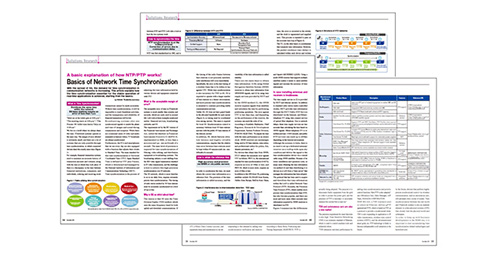
Glossary of technical terms
The following is an explanation of the general technical terms which are commonly used in specifications for GPSDO/GNSSDO and for oscillators (TCXO and OCXO).
Nominal Frequency
It is the output frequency of a TCXO or OCXO which is specified by the oscillator manufacturer (Example: 10MHz).
Accuracy and Stability
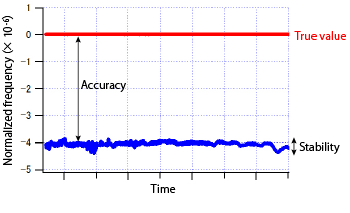
Accuracy is the scale how far apart from the true value. Stability is the scale of variation in accuracy over a period of time. In general, these scales are expressed in ppm(10-6)or ppb(10-9) unit as relative to the value of the nominal frequency (true value). The following formula is used to calculate frequency accuracy.
Fs: Nominal frequency, F: Actual frequency
For example, the nominal frequency is 10,000,000Hz (10MHz) and the actual frequency is 10,000,001Hz, i.e. it is out of alignment by 1Hz.
Coherent
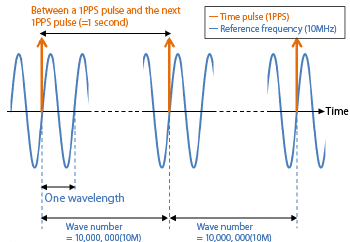
At 10MHz, if the number of cycle of the reference frequency wave between a 1PPS pulse and the next 1PPS pulse is constantly 10,000,000(10M), it means that the time pulse (1PPS) and the reference frequency are coherent. A lot of wireless communication systems such as cell phone base station require such feature.
Variety of Oscillators
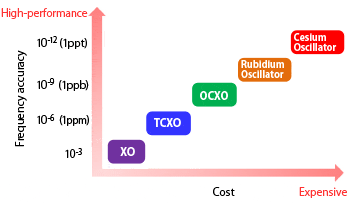
Please refer to the chart for oscillator's frequency accuracy versus cost.
Furuno Multi-GNSSDO provides highly accurate and stable frequency comparable to an atomic oscillator thanks to Multi-GNSS signals reception and FURUNO’s Advanced Oscillator Control Function.
- XO (= Crystal Oscillator)
- A XO is an inexpensive oscillator, often used for in wristwatches.
- TCXO (= Temperature Compensated Crystal Oscillator)
- A TCXO is an oscillator which automatically compensates the alignment of its oscillator frequency for variation of ambient temperature.
- OCXO (=Oven Controlled Crystal Oscillator)
- An OCXO is an oscillator operated inside a temperature controlled oven which keeps the crystal and the oscillator at a constant temperature. This lowers the oscillator frequency variance.
- Atomic Oscillator
- An Atomic Oscillator is an oscillator which outputs high accuracy frequency based on the radiation frequency of atoms or molecules.
List of Technologies
-
What is GPS?


-
Multi-GNSS (Multi-frequency GNSS)


-
Supporting Android™

-
Dead Reckoning(DR)

-
Advanced Multipath Mitigation


-
Active Anti-Jamming


-
Anti-jamming performance of FURUNO Multi-GNSS timing receivers

-
Positioning at 10Hz update rate

-
Self-ephemeris™

-
AGNSS (Assisted GNSS)


-
High sensitivity GPS


-
FURUNO GPS/Multi-GNSS Disciplined Oscillator (GPSDO/GNSSDO)

-
GPS/GNSS GlossaryNEW

-
Strengthening Critical Global Infrastructure: Ushering in an Era of Dual Band GNSS Signal Reception for Time SynchronizationNEW

-
Introduction to GV series products(Flash film contents)

-
What is Frequency generator?(Flash film contents)


